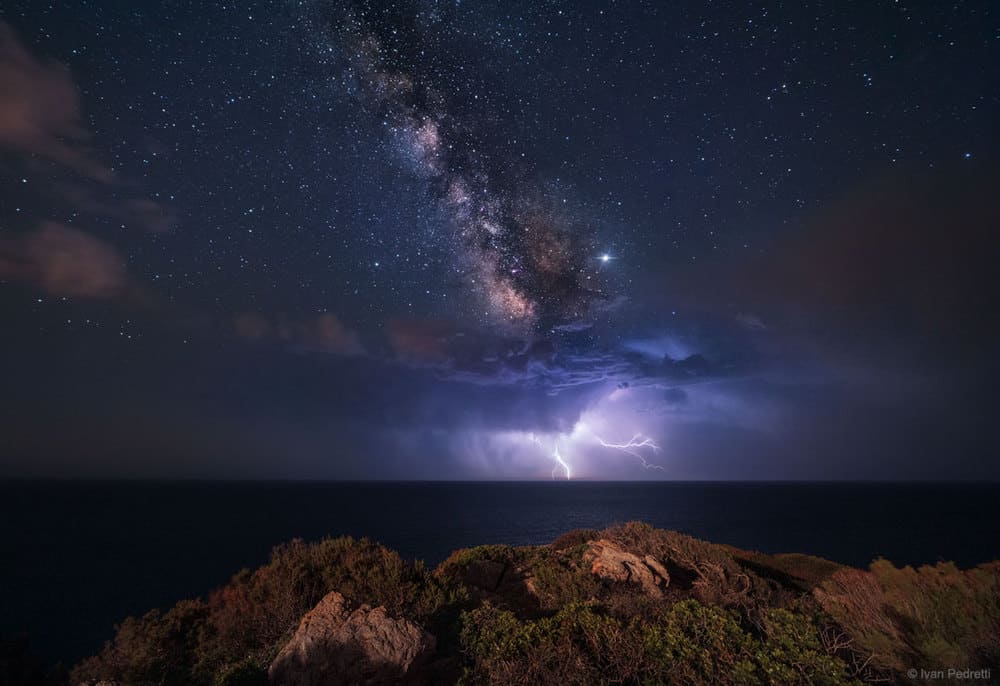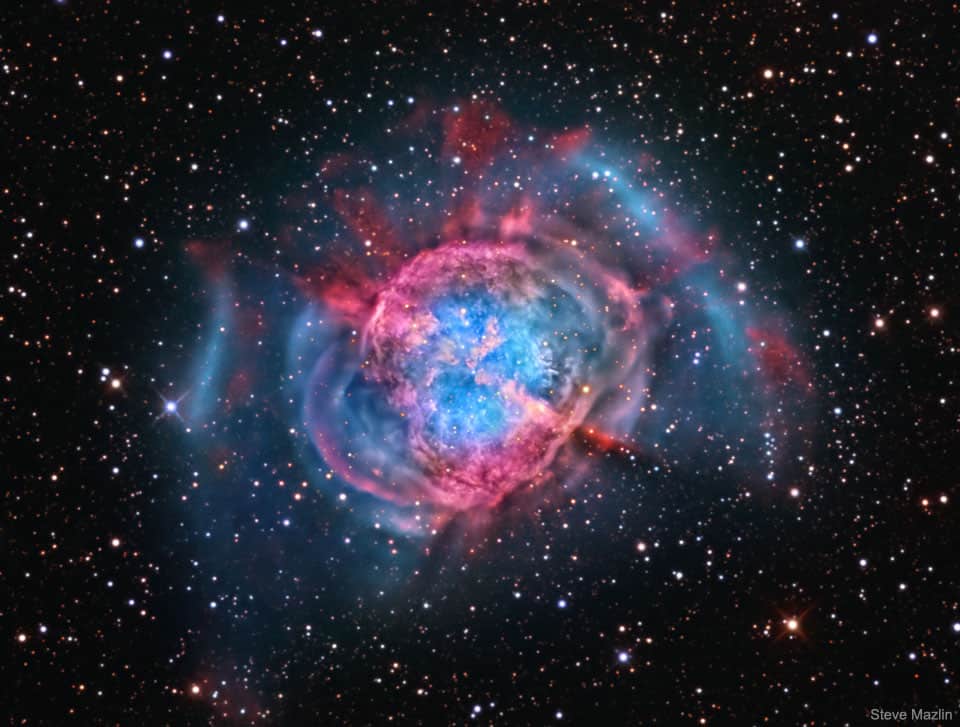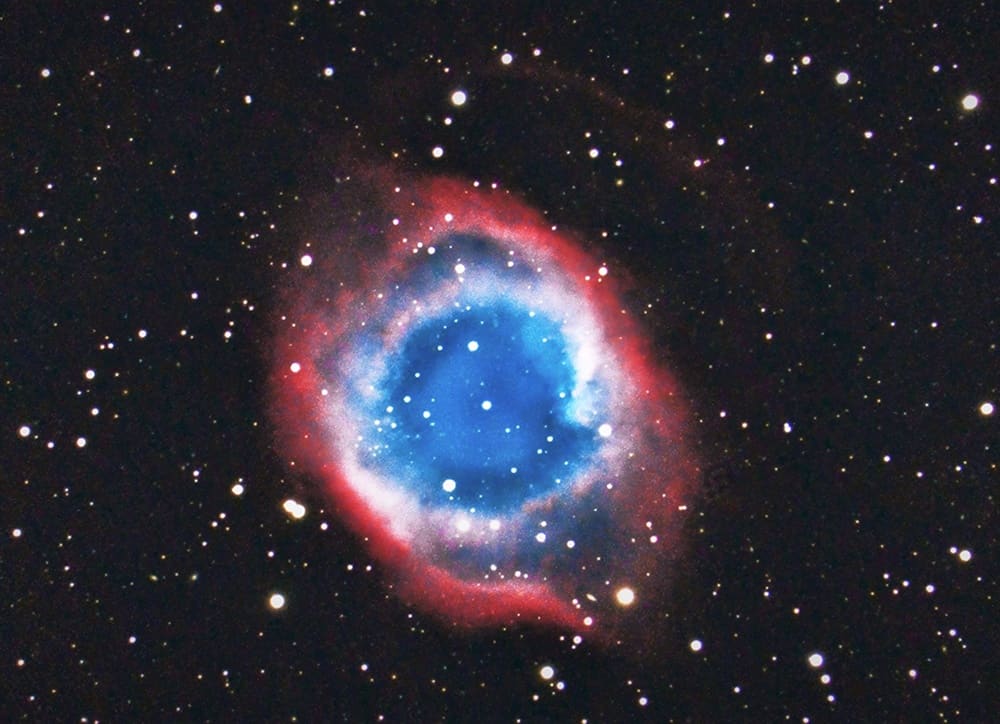Blog
https://www.youtube.com/watch?v=bQevoG946GM
more...The featured nighttime landscape was taken from a southern tip of the Italian Island of Sardinia in early June. The foreground rocks and shrubs are near the famous Capo Spartivento Lighthouse, and the camera is pointed south toward Algeria in Africa. In the distance, across the Mediterranean Sea, a thunderstorm is threatening, with several electric lightning strokes caught together during this 25-second wide-angle exposure. Much farther in the distance, strewn about the sky, are hundreds of stars in the neighborhood of our Sun in the Milky Way Galaxy. Furthest away, and slanting down from the upper left, are billions of stars that together compose the central band of our Milky Way.

Cassandra Wilson (born December 4, 1955) is an American jazz singer, songwriter, and producer from Jackson, Mississippi. Described by critic Gary Giddins as “a singer blessed with an unmistakable timbre and attack [who has] expanded the playing field” by incorporating blues, country, and folk music into her work.
Cassandra Wilson is the third and youngest child of Herman Fowlkes, Jr., a guitarist, bassist, and music teacher; and Mary McDaniel, an elementary school teacher who earned her PhD in education. Her ancestry includes Fon, Yoruba, Irish and Welsh. Between her mother’s love for Motown and her father’s dedication to jazz, Wilson’s parents sparked her early interest in music.
more...Christopher “Chris” Hillman (born December 4, 1944) is an American musician. He was the original bassist and one of the original members of The Byrds, which in 1965 included Roger McGuinn, Gene Clark, David Crosby and Michael Clarke. With frequent collaborator Gram Parsons, Hillman was a key figure in the development of country rock, defining the genre through his work with The Byrds, The Flying Burrito Brothers, Manassas and the country-rock group Desert Rose Band.
Hillman was born in Los Angeles, California, the third of four children. He spent his early years at his family’s ranch home in rural northern San Diego County, approximately 110 miles (180 km) from Los Angeles. His mother was Presbyterian and his father was Jewish. He has credited his older sister with exciting his interest in country and folk music when she returned from college during the late 1950s with folk music records by The New Lost City Ramblers and others. Hillman soon began watching many of the country-music shows on local television in southern California at the time such as Town Hall Party, The Spade Cooley Show and Cal’s Corral. Hillman’s mother encouraged his musical interests and bought him his first guitar; shortly thereafter he developed an interest in bluegrass, particularly the mandolin. At age 15 Hillman went to Los Angeles to see the Kentucky Colonels bluegrass band at the Ash Grove, and later convinced his family to allow him to travel by train to Berkeley for lessons from mandolinist Scott Hambly. When he was 16, Hillman’s father committed suicide.
more...Larry Davis (December 4, 1936 – April 19, 1994) was an American electric Texas blues and soul blues musician. He is best known for co-writing the song “Texas Flood“, later recorded to greater commercial success by Stevie Ray Vaughan.
Davis was born in Pine Bluff, Arkansas, and was raised in England, Arkansas, and Little Rock, Arkansas. He swapped playing the drums to learn to play the bass guitar. In the mid-1950s, he had a working partnership with Fenton Robinson, and following the recommendation of Bobby Bland was given a recording contract by Duke Records. Davis had three singles released, which included “Texas Flood” and “Angels in Houston”. Thereafter, he had limited opportunity in the recording studio. He resided in St. Louis, Missouri, for a while, and played bass in Albert King‘s group. He also learned to play the guitar at this time; the guitar on Davis’s recording of “Texas Flood” was by played by Robinson.
Several single releases on the Virgo and Kent labels followed, but in 1972 a motorcycle accident temporarily paralyzed Davis’s left side. He returned a decade later with an album released by Rooster Blues, Funny Stuff, produced by Oliver Sain. He won four W. C. Handy Awards in 1982, but a decade later he was known only to blues specialists. His 1987 Pulsar LP, I Ain’t Beggin’ Nobody, was difficult even for blues enthusiasts to locate.
In 1992, Bullseye Blues issued another album, Sooner or Later, highlighting his booming vocals and guitar playing influenced by Albert King. Davis died of cancer in April 1994, at the age of 57.
more...James Stanley Hall (December 4, 1930 – December 10, 2013) was an American jazz guitarist, composer and arranger. Premier Guitarmagazine stated that “It could be argued that the jazz guitar tree is rooted in four names: Django [Reinhardt], Charlie [Christian], Wes[Montgomery], and Jim [Hall]”.
Born in Buffalo, New York, before moving to Cleveland, Ohio, Hall was from a musical family, his mother played the piano, his grandfather violin, and his uncle guitar. He began playing the guitar at age ten when his mother gave him an instrument as a Christmas present. At 13 he heard Charlie Christian play on a Benny Goodman record, which he calls his “spiritual awakening”. As a teenager in Cleveland, he performed professionally, and also took up the double bass. Hall’s major influences since childhood were tenor saxophonists Coleman Hawkins, Lester Young, Paul Gonsalves, and Lucky Thompson. While he copied out solos by Charlie Christian, and later Barney Kessel, it was horn players from whom he took the lead.
more...https://www.youtube.com/watch?v=5-KcRKIaVQo
more...The first hint of our Sun‘s future was discovered inadvertently in 1764. At that time, Charles Messier was compiling a list of diffuse objects not to be confused with comets. The 27th object on Messier’s list, now known as M27 or the Dumbbell Nebula, is a planetary nebula, the type of nebula our Sun will produce when nuclear fusion stops in its core. M27 is one of the brightest planetary nebulae on the sky, and can be seen toward the constellation of the Fox (Vulpecula) with binoculars. It takes light about 1000 years to reach us from M27, featured here in colors emitted by hydrogen andoxygen. Understanding the physics and significance of M27 was well beyond 18th century science. Even today, many things remain mysterious about bipolar planetary nebula like M27, including the physical mechanism that expels a low-mass star’s gaseous outer-envelope, leaving an X-ray hot white dwarf.

John Michael “Ozzy” Osbourne (born 3 December 1948) is an English singer, songwriter, actor and reality television star who rose to prominence during the 1970s as the lead vocalist of the heavy metal band Black Sabbath, during which he adopted the nickname “The Prince of Darkness”.Osbourne was fired from the band in 1979 due to alcohol and drug problems, but went on to have a successful solo career, releasing eleven studio albums, the first seven of which were all awarded multi-platinum certifications in the United States. Osbourne has since reunited with Black Sabbath on several occasions. He rejoined the band in 1997 and helped record the group’s final studio album 13 (2013) before they embarked on a farewell tour which culminated in a final performance in their home city, Birmingham, England, in February 2017. His longevity and success have earned him the informal title of “Godfather of Heavy Metal“.
Osbourne’s total album sales from his years in Black Sabbath, combined with his solo work, is over 100 million. As a member of Black Sabbath, he was inducted into the Rock and Roll Hall of Fame, and he was inducted into the UK Music Hall of Fame as a solo artist and as a member of the band. Possessing a distinctive singing voice, Osbourne, as a native of Birmingham, is known for his strong Brummie accent – he has a star on the Birmingham Walk of Stars in his hometown as well as the Hollywood Walk of Fame. At the 2014 MTV Europe Music Awards, he received the Global Icon Award. In 2015 Osbourne received the Ivor Novello Award for Lifetime Achievement from the British Academy of Songwriters, Composers and Authors.
In the early 2000s, Osbourne became a reality television star, appearing as himself in the MTV reality show The Osbournes, alongside wife and manager Sharon and two of their three children, Kelly and Jack. He currently co-stars with Jack and Kelly in the television series Ozzy & Jack’s World Detour. The show’s third season debuted in June 2018.
more...Joseph William “Joe” Thomas, also known as Brother Cornbread (December 3, 1902 – February 18, 1981) was an American jazz clarinetist and singer, closely associated with the New Orleans jazz scene.
Thomas’s first professional gig was in New Orleans with trombone player Joe Harris in 1923. Soon after that, he worked with Jack Carey, Chris Kelly, and Kid Rena. He recorded with Charles Derbigny in 1941, but the recordings were not publicly released until the 1960s, by which time Thomas had become a figure in the Dixieland revival movement. He led his own ensemble at New Orleans’s H&J Tavern for much of the 1940s, then, in 1951, became a sideman for Papa Celestin. He worked with this ensemble for years, including after Papa French and Eddie Pierson had taken over as leader. Other associations in the 1950s and 1960s included work with Freddie Kohlman, Punch Miller, the Olympia Brass Band, and on Swedish television with Sweet Emma Barrettin 1968. In the 1970s he worked with the Legends of Jazz, replacing Joe Darensbourg.
more...The Helix Nebula (NGC 7293) is a large planetary nebula in the constellation Aquarius. The thirty-eight 10-minute exposures that the photographer combined to make this image were taken over three nights. The Helix Nebula, also known as NGC 7293, is a planetary nebula (PN) located in the constellation Aquarius. Discovered by Karl Ludwig Harding, probably before 1824, this object is one of the closest to the Earth of all the bright planetary nebulae. The distance, measured by the Gaia mission, is 655±13 light-years. It is similar in appearance to the Cat’s Eye Nebula and the Ring Nebula, whose size, age, and physical characteristics are similar to the Dumbbell Nebula, varying only in its relative proximity and the appearance from the equatorial viewing angle. The Helix Nebula has sometimes been referred to as the “Eye of God” in pop culture, as well as the “Eye of Sauron“. Distance 650 ly away.

Tal Wilkenfeld (born 2 December 1986) is an Australian singer, songwriter, bassist, and guitarist whose career began performing alongside artists including Jeff Beck, Prince, Eric Clapton, Herbie Hancock and Mick Jagger. In 2008, Wilkenfeld was voted “The Year’s Most Exciting New Player” by Bass Player magazine readers’ choice poll. In 2013, Wilkenfeld was awarded Bass Player Magazine’s “Young Gun Award” by Don Was, where she performed “Chelsea Hotel” by Leonard Cohen.
Wilkenfeld is a bandleader of her own eponymous bands in which she sings, plays bass and guitar. In her earlier work, she was backed by musicians such as Wayne Krantz and Vinnie Colaiuta. She opened for The Who on the North American part of The Who Hits 50! tour in 2016. In 2016, Wilkenfeld released a single entitled “Corner Painter” which features Blake Mills and Benmont Tench. Rolling Stone praised “Wilkenfeld is working on new music that sees her evolving from an instrumental prodigy into a formidable singer-songwriter” On March 15, 2019, Wilkenfeld released her vocal debut album Love Remains, which reached No. 1 on the Billboard Heatseeker charts on the first week of its release. Love Remains has been highly praised by the press and featured in Rolling Stone, Relix, Paste, Billboard and Forbes. Rolling Stone described Wilkenfeld’s vocal debut as “ten dense, riff-heavy tracks with brazen, introspective lyrics—prove her songwriting abilities.” Wilkenfeld has also been a guest on popular podcasts including Marc Maron and Bill Burr. Wilkenfeld was featured on the cover of Bass Player magazine’s March 2019 issue. On July 22, 2019, Wilkenfeld appeared on Jimmy Kimmel Live, performing “Killing Me” and “Corner Painter”.
more...Wynton Charles Kelly (December 2, 1931 – April 12, 1971) was an American jazz pianist and composer. He is known for his lively, blues-based playing and as one of the finest accompanists in jazz. He began playing professionally at the age of 12, and was pianist on a No. 1 R&B hit at the age of 16. His recording debut as leader occurred three years later, around the time he started to become better known as accompanist to singer Dinah Washington, and as a member of trumpeter Dizzy Gillespie‘s band. This progress was interrupted by two years in the United States Army, after which Kelly returned to Washington and Gillespie, and played with other leaders. Over the next few years, these included instrumentalists Julian “Cannonball” Adderley, John Coltrane, Roland Kirk, Wes Montgomery, and Sonny Rollins, and vocalists Betty Carter, Billie Holiday, and Abbey Lincoln.
Kelly attracted the most attention as part of Miles Davis‘ band from 1959, including an appearance on the trumpeter’s Kind of Blue, often mentioned as the best-selling jazz album ever. After leaving Davis in 1963, Kelly played with his own trio, which recorded for several labels and toured the United States and internationally. His career did not develop much further, and he had difficulty finding enough work late in his career. Kelly, who was prone to epilepsy, died in a hotel room in Canada following a seizure, aged 39.
more...Charlie Ventura (born Charles Venturo; December 2, 1916 – January 17, 1992) was a tenor saxophonist and bandleader from Philadelphia, Pennsylvania.
Ventura had his first taste of success working with Gene Krupa. In 1945 he won the Down Beat readers’ poll in the tenor saxophone category.[1][2] In the late 1940s he led several popular groups and went on to become known for his “bop for the people,” with vocalists Jackie Cain and Roy Kral.
After the early 1950s he made only a few recordings. His first was the debut album for Gene Norman’s GNP Crescendo label (GNPD No. 1) recorded live in Los Angeles. In Las Vegas, he worked with Jackie Gleason and was the featured soloist on four albums Gleason produced : Riff Jazz (1958), on which he played alto, tenor, and bass saxophones; Silk and Brass (1965); A Taste of Brass for Lovers Only (1967); and Doublin’ in Brass (1968)
Ventura died of lung cancer in Pleasantville, New Jersey at the age of 75.
more...https://www.youtube.com/watch?v=hizE1sfRWLc
more...More Posts
- Chas Chandler
- Wadada Leo Smith
- Pee Wee Crayton
- Harold Land
- Eddie “Cleanhead” Vinson
- World Music Vasilis Kostas & Petroloukas Halkias
- Daily Roots Eric Morris
- Santa & Jesus Expression of Love
- Challenge to Change at Wildflower Coffee
- Cosmos IC 1805
- Carlton Barrett
- Eddie Kendrick
- Art Neville
- Paul Butterfield
- James Booker
- World Music Lebeha Drummers
- Daily Roots Scientist
- Cosmos NGC 2566
- Sugar Blue
- Robben Ford